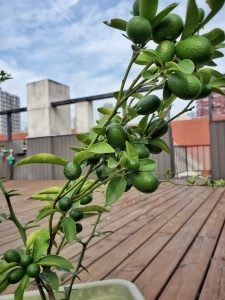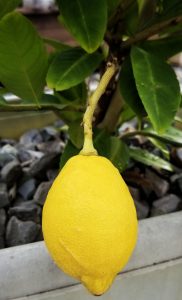Kumquat (金橘, Jīn jú)
Kumquats are some of the easiest fruit trees to grow in pots here in Shanghai. Plant a kumquat tree in a sunny site with fairly loose, well-draining soil. They will not do well in dense clay soils as they can be susceptible to root rot. A layer of mulch over the top of the container will help preserve soil moisture during Shanghai summers, but keep the mulch away from from the trunk to avoid fungal problems. Kumquats are self-pollinating, so a single tree will produce fruit.
Kumquats are hardy down to around -8 degrees Celsius. In a normal Shanghai winter they should survive without too many problems, but if a particularly cold snap is forecast, either bring your tree indoors to a bright, sunny location, or if that’s not possible, wrap the pot itself to keep the roots warm and cover the leaves in a frost cloth.
Kumquat trees need full sun and at least six hours of sunlight a day. If growing indoors, give it as much light as possible, taking care that any direct sunlight doesn’t burn the leaves through the glass.
Like all citrus, feed your kumquat with a proper citrus fertilizer during the growing season to encourage healthy growth. Feeding is not needed over winter.
Repot your kumquat every two to three years into a container that is slightly larger than the original. These plants do not like to be root bound. The best time to repot citrus is the beginning of spring, during the leaf-growing stage
Kumquats grow beautifully in containers. See Lemon below for an analysis of pot types. I personally prefer a raised plastic pot as you will see below, but whether you choose plastic, wood, or a stone pot always be sure to check that it has good drainage.
Potted kumquats are susceptible to mealy bug infestations and root rot diseases. Combat this by not allowing the plant to become waterlogged and making sure the soil is well-drained before planting. Also, avoid piling mulch around the base of the tree. Aphids and scale can also be a problem. Neem oil may help.

Lemon (柠檬, Níngméng)
While it is possible to grow a lemon tree from seed I’d only recommend it for those who don’t mind waiting a few years to see a lemon – it can take around 4 years before lemons grown from seeds produce fruit. Instead, try to buy and already established plant (usually grown by grafting rather than seed) that is at least 2 or 3 years old. That way you won’t have to wait for your tree to start blooming and setting fruit. There are even dwarf varieties available that are designed to do well in containers, if that’s your plan, although any variety of lemon can be grown in a pot without too much stress.
For container growing, choose a pot that’s around 25% bigger than the root ball of the plant. The type of pot you choose depends on how often you will be around to water your plant. Lemons despise being overwatered and so many people will opt for a clay or terracotta pot because they are porus and will let the water evaporate quickly. I personally wouldn’t recommend this, unless your plan is to be watering twice a day over summer. All my citrus are in raised plastic pots which allow any excess water to drain out the bottom without keeping the trees standing in a puddle, while the plastic helps retain water which is essential over summer. I have also added a layer of stones to the top of the soil which helps keep the water in over summer, and I push these away over winter to avoid waterlogging.
Lemon trees will need repotting every 2 or 3 years, into a pot that is one size larger than the current pot. The best time to do this is in the spring.
Like all citrus, lemons love full sunshine, around 7 to 8 hours a day. If you decide to grow your lemon tree indoors, place it near a window with ample sunlight. They don’t like too much wind though so if possible locate your tree in a sheltered area. However if that is not possible don’t panic. My citrus trees are located in a relatively exposed position and have survived several typhoons so far, albeit with some broken branches.
All varieties of lemon are cold tolerant down to 0 degrees Celsius. Any lower than that and you will either need to bring your tree indoors or cover it with a frost cloth to ensure it survives the cold.
Lemon trees will need frequent fertilizing in order to produce lots of fragrant flowers, big juicy fruit and healthy leaves. Look for a fertilizer specifically for citrus plants and that will contain all the micronutrients your tree needs, especially iron, manganese, and zinc.
Curled leaves typically indicate insufficient moisture, or a possible insect attack, while yellow leaves could be due to a lack of nutrients. There are many websites that will help you identify any problems with your tree by the condition of the leaves.
Wash the tree periodically with a strong spray of water to remove any pests. This is usually adequate for pest prevention but if a pest problem does occur, treat it as necessary for the specific problem. Snails, mites, aphids and scale insects sometimes attack lemon trees and a mixture of organic neem oil mixed with water can be one solution to this problem.

Blueberries (蓝莓, Lánméi)
Blueberries are very resilient plants and can withstand temperatures from -20 ° C to -25 °C without any damage. In the summer though when temperatures are high blueberry plants will need a lot of moisture. This is due to the very shallow root system. Without enough water the bushes can quickly die. Unfortunately they don't much like soggy soil either, so it's best to give them a soil that holds moisture but also drains well and doesn’t stay wet. Blueberries are usually planted in October and November in locations exposed to the sun and with good air circulation. They can also be set out in the spring. To get fruit, it's best to plant a minimum of 2 bushes in a patch, rather than scattered throughout your garden. This will boost berry production and quality. Blueberries thrive in soil that is acidic, so if possible amend your soil before planting with a small amount of granulated sulfur several months before planting. Tip: Be careful not to plant the bushes too deeply. The rootball should be just below the surface. Apply fertilizer one month after planting, not at the time of planting. Blueberries grown in containers are easier to protect from birds and other critters, are more disease resistant, easy to harvest, and easy to move if needed.
